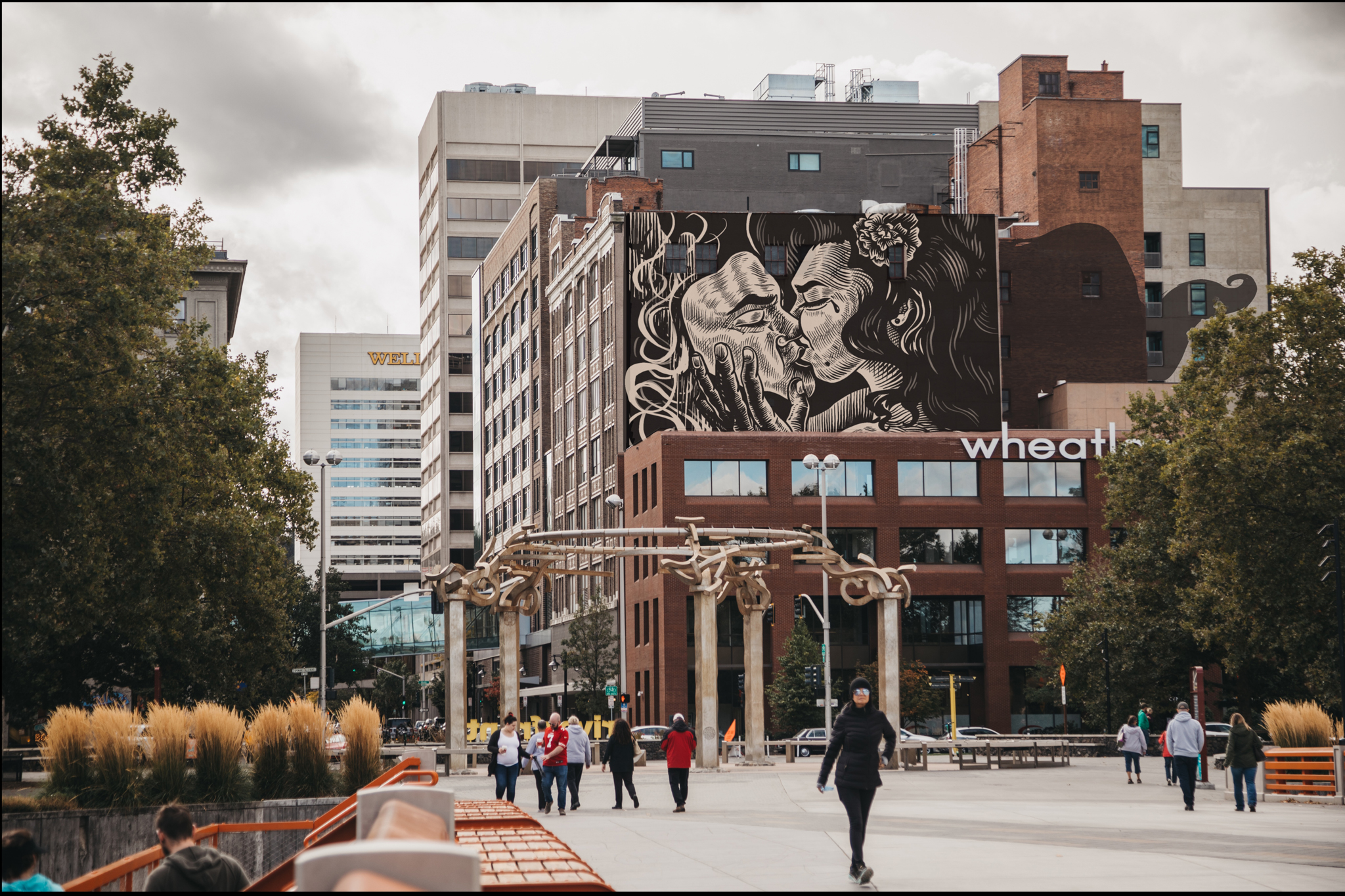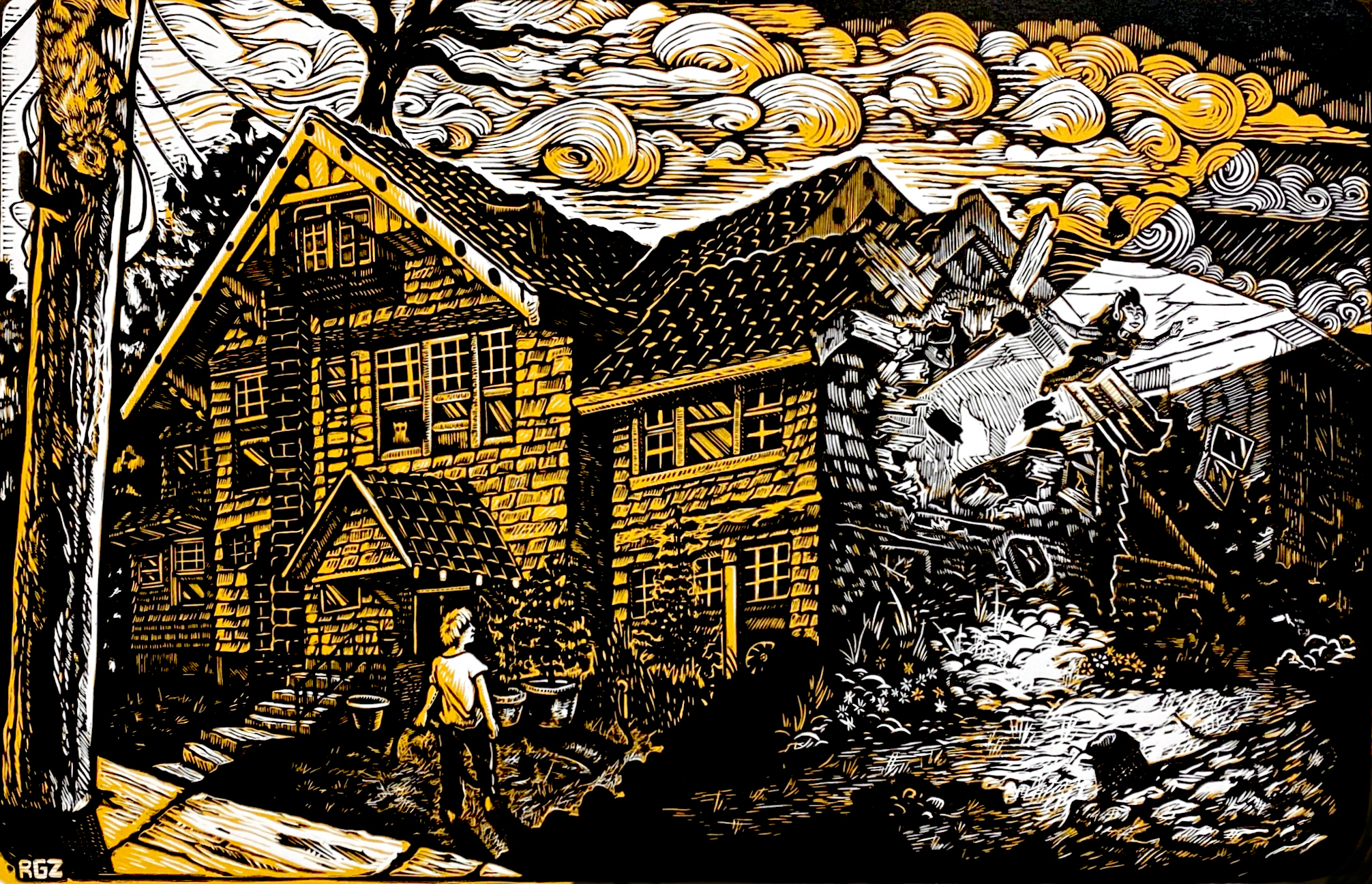The art of printmaking begins with a story
An artist’s tools — paint brushes, pencils, carving knives — have been shaped over the years to fit the hands that use them. They are an extension of human motion. But for Spokane printmaker Reinaldo Gil Zambrano, his tools go beyond the norm. He uses thousand-pound printing presses and industrial steam and asphalt rollers: anything but palmsize.
The expanse, and expense, of the printmaker’s toolbox has left printmaking mostly inaccessible. Reinaldo, also known as RGZ, wants to change that.
Born in Caracas, Venezuela in 1990, Reinaldo grew up in an environment that fueled his creativity. Taking inspiration from his family’s support, Reinaldo played with different artistic mediums from a young age.
“I grew up drawing cartoons, copying comic books and children’s books my mom gave me, using charcoals, doing paper mache from magazines — I experimented and was never conventional,” Reinaldo said. “My parents were always supportive, allowing me to paint on my walls and my clothes.”
As a teenager, Reinaldo attended the United World College Costa Rica and received a bilingual diploma.

Surrounded by students from around the world, it was here Reinaldo recognized his ability to tell stories not through sound but through sight.
With a large international scholarship and a desire to study the arts, Reinaldo moved from Latin America to Idaho.
At the University of Idaho Reinaldo was introduced to printmaking, teaching and his future wife Ashley. He fell in love with all three.
At the university, he organized the now-annual Vandal Steam Roller Project, creating large-scale prints with sidewalk-sized stamps, bedsheets, and a steamroller.
“[Reinaldo is] an amazing example of what a creative leader is and should be,” said Chelsea Marie Flores, a fellow printmaker and former student of Reinaldo’s. “His hard work and talent has made a huge impact on the Pacific Northwest and beyond. The arts community is better with him in it.”
Although he steamrolls for events, like Emerge’s INK! Print Rally in Coeur d’Alene, Reinaldo uses more traditional printmaking methods for his own pieces.
His go-to print style is relief printing, a process in which an artist carves away negative space to create a “stamp” for the inking process.
First, Reinaldo starts with a story.
“I think back to stories I’ve heard and that triggers an idea,” he said. “I’ll focus on the meaning behind a story and how I can preserve the storytelling process through art.”
He grabs a piece of fiberboard, sometimes up to 6 feet in length, and sketches his idea with a pencil. Using a string and ruler to ensure lines are straight and symmetrical, Reinaldo takes a permanent marker to outline the bolder areas.
The finished product will be two dimensional, but Reinaldo’s pieces appear 3D. The detailed cross-hatching, shading and fine lines breathe life into his whimsical works. Viewers can almost run their hands along the fence posts in his depictions of home.
With the drawing laid out, he stains the block with acrylic paint to see his carvings as he works — leaving his raised drawing to be inked with a rolling-pin-like tool.
A piece of paper, fabric, or canvas is then laid carefully on the block. Reinaldo will place the “paper-stamp-sandwich” into a printing press that will create a “pressure sandwich.” Depending on the size of the piece, the paper and block will be smashed together by a small metal plate or roll through a machine that operates much like a miniature steamroller.
The initial image Reinaldo stamps is traditionally black, because it “renders images perfectly.” If he wants to add additional details or a layer of color, Reinaldo will carve the block again and leave raised only the extra details. Creating these layers adds luminosity to an otherwise flat piece and gives Reinaldo that 3D effect.
He may use the block just once or as many as 40 times, small differences occurring between the prints. Reinaldo then signs and numbers each one-of-a-kind, limited edition piece of art.
“My favorite part of printmaking is that I can transform myself into different roles,” Reinaldo said. “First, I am an illustrator drawing my vision. Then I am a carver and last an inker. There is a place for experimentation at every phase.”

Often described as “magical realism,” Reinaldo’s work highlights the unified human experience through Western and Hispanic iconography. Using black ink and bright yellows to illuminate the darkest places, he creates graphic stories that share the universal feeling of home.
“I believe everyone has an internal home and an external home,” he said. “Your internal home is always changing through your experiences, and your external home is always changing through your surroundings.”
Without access to a university and its resources, it’s difficult to be a printmaker. Most people can not afford the expensive printmaking equipment — printing presses, drying racks, inks, cleaning supplies and more. To fill the need, Reinaldo created his public printmaking shop RGZPrints.
“I believe in teaching through doing,” Reinaldo said. “I like to guide new artists so they can come back and become the teachers themselves.”
Looking to expand, RGZPrints partnered with Millwood Print Works and Bottlecrow Publications to open the Spokane Print & Publishing Center (SPPC), a community facility with workshops, classes, gallery shows, and access to expensive print and publishing tools. Here people can learn letter pressing, book binding, action figure modeling, board game designing and printing on Victorian era presses.
“[Reinaldo is] so committed to building the printmaking community in Spokane and his energy is contagious,” said Thom Caraway, a co-founder and letterpress instructor at SPPC. “He is always looking for ways to collaborate with all kinds of artists…People see his work, and I think they can see what the art form is really capable of because his work is so evocative and intricate.”
In partnership with Terrain, a Spokane nonprofit arts organization, Reinaldo also hosts the Spokane Print Fest. The one-day event is an annual print celebration with gallery shows, artist demos, workshops and more. For Reinaldo, the reward is when different members of the community can teach and share with each other.
“As a printmaker you can be solitary, carving for hours at your desk,” he said. “But I think of printmaking as a communication tool to reach more people, ask for help, and preserve stories. It goes beyond limitations of cultural and language barriers.”
Reinaldo has definitely found success in Spokane. But is he not one to be limited. His pieces have been shown around the country and around the world: Puerto Rico, Mexico, Spain, Australia and back in his home country of Venezuela.
Reinaldo has created a movement. He encourages the art world with a spirit of creation and togetherness. And Spokane has the pleasure of watching it all. N
By Rosemary Anderson
Photography By Joel Riner


